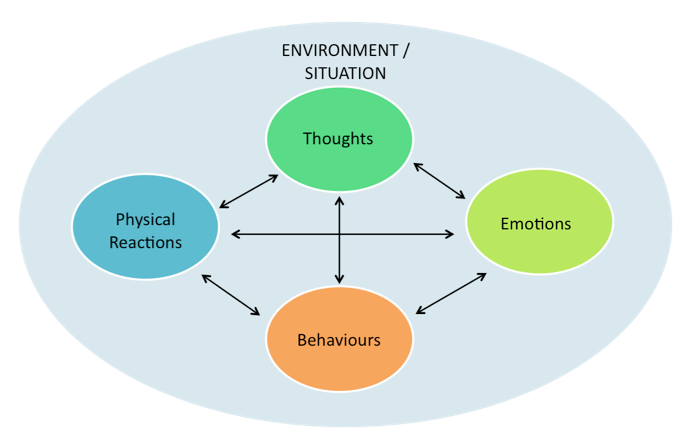Emotions come about from a combination of what is happening around us, what we are doing, reactions in our body, and what we are thinking about a situation.
Emotional Functioning
Emotions are specific reactions to a particular event. For example, you feel annoyed when your favourite team loses a game, or excited when you are being visited by a loved one you haven’t seen for a while. Sometimes these feelings last for a longer time (a day or more) and can include happiness, sadness, frustration, contentment, or anxiety.
Emotions come about from a combination of what is happening around us, what we are doing, reactions in our body, and what we are thinking about a situation.

Sometimes it might feel like our emotions come on with no warning or reason at all, but with practice you can learn to spot some of the other things that are contributing to the way you are feeling.
The way you THINK about a situation can have a VERY powerful effect on your emotions and the things you do.
People with a brain injury may have a tougher time managing their emotions for different reasons:
- The injury itself: sometimes parts of the brain that help keep emotions under control may be damaged. This means that a person might be more prone to mood swings, or have a shorter fuse than before;
- People with a brain injury might get more overwhelmed in situations and find it harder to cope. For example, going to the mall might be too noisy and busy for them, which can be scary;
- People with a brain injury might find it hard to get back to things they had done previously, such as work, driving, sports etc. Dealing with change can be stressful
So what can I do?
If someone meets with a psychologist because they are having problems with their emotions (for example, they are always feeling sad, or they are having problems managing their anger, or they experience a lot of fear or anxiety), treatment often involves trying to work on their THOUGHTS, their BODY REACTIONS and WHAT THEY DO. But there is plenty you can try to do on your own…
Things you can do to help yourself might include:
- Changing your BEHAVIOUR
- Make an effort to do nice things or see people, even if you don’t feel like it.
- Make a list of things to do for the day and try to complete it, to feel like you’ve achieved
- Make sure to eat healthily
- Try to do some gentle exercise
- Think about new hobbies or activities you might be able to try
- Try to stop avoiding things that you’re worried about. Start off small (for example, if you’re scared about going out in public, start with walking to your local dairy before trying to go to the mall)
- Before getting confrontational, count to 10, or try to walk away and calm down
- Take some time to think about how you’re going to get your message across to people without losing your temper
- Managing your PHYSICAL REACTIONS
- Make sure to get enough sleep overnight. You may have to rest during the day as well
- Do things to slow down your body. This can include slow breathing, muscle relaxation, imagining relaxing scenes, having a hot shower, etc.
- Looking at your THOUGHTS
- Try to think about the positive things that have happened each day, even if they were only small
- Think about what you CAN do, rather than just focusing on what you CAN’T
- Ask yourself what you’re really scared about, and how bad that would be, and how likely. Think about the times in the past that you have coped when you have been scared
- Ask yourself whether people are really doing things to annoy you on purpose. Are you jumping to conclusions? Are there other ways to think about the situation?
Relaxation Exercises
Slow Breathing
Learning to manage your breathing can be beneficial for your body and your mind. If you are feeling stressed, even taking one good slow deep breath can be helpful.
- Sit or lie comfortably – try to make sure your body feels kind of even. Sit with your arms and legs relaxed (not crossed).
- Place one or both hands on your stomach so that you can notice your stomach move as you breathe in and out.
- Breathe in slowly and gently through the nose and out slowly and gently through the mouth (or the nose). The trick is to make sure that your out-breath is complete (probably it’ll be a little longer than the in-breath).
- Just sit (or lie) and notice the rhythm of your breathing. You do want to breathe in a slow and relaxed manner, but don’t force it to be this way. Some days you may notice that your breathing is more relaxed, and on other days it will be harder work to achieve this.
- Start off doing this for 5 minutes. You can build up to practising breathing for 20 – 40 minutes.
- Keep practising to develop this skill.
Body Scan
While noticing your breathing you can become aware of your body and consciously choose to relax all of your body in a step-by-step manner.
- Start with becoming aware of your toes and your feet. Focus on your toes and feet and “breathe in” to this part of your body.
- Move up the body becoming aware of your lower legs, your knees, your upper legs and up to your buttocks
- Become aware of your stomach, your back, your chest
- Become aware of your hands and move up your arms to your shoulders
- Become aware of your neck and the top of your spine
- Then move to your face, ears, and scalp – get quite detailed here – be aware of your eyes and your forehead and breathe into everything.
You may wish to add to your breathing practice by taking yourself in your mind to a place where you feel good and strong.
